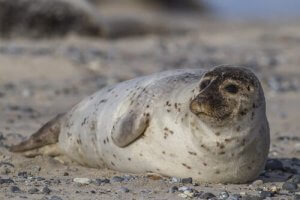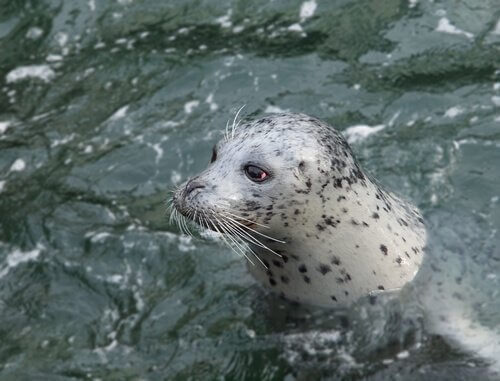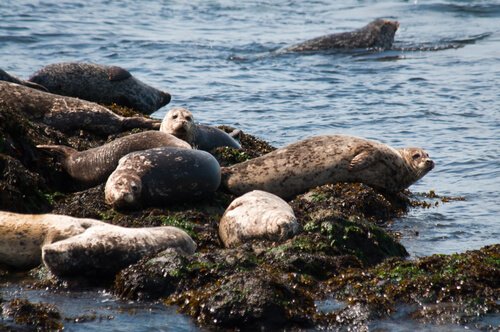Characteristics of the Harbor Seal

The common seal is also known as speckled or harbor seal. It inhabits the temperate and cold water coasts, and is the most widespread species of pinnipeds in the world. Continue reading to find out more about it.
Physical characteristics of the harbor seal
Its scientific name is Phoca vitulina and its body may be gray, cinnamon brown or just plain brown. Each specimen has a unique pattern of darker spots throughout the body. These markings can be black or brown, and yet the belly is always light.
One of the main characteristics of a harbor seal is its “v” shaped nostrils. In addition to this, they don’t have ears nor ear pavilions.
Adults can weigh up to 300 pounds and are almost 6 feet long. The females are smaller than the males, but they can live longer –35 and 25 years respectively. The males’ lifespan is shorter because of the stress they have to endure every year before reproduction.
Even though they seem a bit clumsy when moving on dry land, their small, flexible, five-digit, front fins allow them to swim very fast.

Habitat and feeding of the harbor seal
The harbor seal population is estimated at 500,000, and so it isn’t an endangered species. The exception to this are the seals that inhabit the Baltic Sea, Hokkaido, and Greenland, where many of them die as a result of illegal fishing and commercial hunting.
There are currently five subspecies of spotted, or harbor seals:
- Western Atlantic Common seal (lives in North America)
- Ungava seals (originally from eastern Canada)
- Pacific Common seals (of western North America)
- Insular seal (lives in East Asia)
- Eastern Atlantic Common seals (found in Europe and Asia, and the best known)
When it’s time to eat, the harbor seal is known for its ability to catch its prey while swimming at high speed. The species included in their diet are anchovy, herring, sea bass, cod, shrimp and squid.
The seals can dive for up to 10 minutes without coming to the surface to breathe, reaching up to 1,600 feet underwater during that time. It’s also a piece of cake for them to dive up to 65 feet under the water to fish.

The behavior of the harbor seal
Harbor seals are very attached to their families, and are always seen in groups. Thanks to this, they are protected from predators. It’s also a gregarious and polygamous species, whose females reach sexual maturity at the age of two. The males aren’t ready until five years of age.
To mate, the males fight each other in the water, and the “winners” have the right to mate the females. The females prefer only the strongest specimens. The mothers – which give birth once a year after a gestation period of 11 months – are the only ones in charge of taking care of the young. The baby seals are born weighing around 35 pounds and, just a few hours after they are born, they are swimming and diving around the water.
In just four weeks they triple in size, thanks to their intake of high-fat milk.
During molting season they spend a lot of time on the coast, lying around. Although they can move up to 20 miles from their home base and spend several days at sea, they always return to that same place after eating.
The areas chosen by these pinnipeds to start their families are rocky and rough coasts, as well as sandy beaches. Their habits may change due to the presence of human beings in their surroundings. When they sense any danger they quickly dive into the water.
The common seal is an amazing animal. Furthermore, it has sensor-like whiskers that detect vibrations under the water. Another interesting fact is that each one of them could eat up to 20 pounds of food per day!
The common seal is also known as speckled or harbor seal. It inhabits the temperate and cold water coasts, and is the most widespread species of pinnipeds in the world. Continue reading to find out more about it.
Physical characteristics of the harbor seal
Its scientific name is Phoca vitulina and its body may be gray, cinnamon brown or just plain brown. Each specimen has a unique pattern of darker spots throughout the body. These markings can be black or brown, and yet the belly is always light.
One of the main characteristics of a harbor seal is its “v” shaped nostrils. In addition to this, they don’t have ears nor ear pavilions.
Adults can weigh up to 300 pounds and are almost 6 feet long. The females are smaller than the males, but they can live longer –35 and 25 years respectively. The males’ lifespan is shorter because of the stress they have to endure every year before reproduction.
Even though they seem a bit clumsy when moving on dry land, their small, flexible, five-digit, front fins allow them to swim very fast.

Habitat and feeding of the harbor seal
The harbor seal population is estimated at 500,000, and so it isn’t an endangered species. The exception to this are the seals that inhabit the Baltic Sea, Hokkaido, and Greenland, where many of them die as a result of illegal fishing and commercial hunting.
There are currently five subspecies of spotted, or harbor seals:
- Western Atlantic Common seal (lives in North America)
- Ungava seals (originally from eastern Canada)
- Pacific Common seals (of western North America)
- Insular seal (lives in East Asia)
- Eastern Atlantic Common seals (found in Europe and Asia, and the best known)
When it’s time to eat, the harbor seal is known for its ability to catch its prey while swimming at high speed. The species included in their diet are anchovy, herring, sea bass, cod, shrimp and squid.
The seals can dive for up to 10 minutes without coming to the surface to breathe, reaching up to 1,600 feet underwater during that time. It’s also a piece of cake for them to dive up to 65 feet under the water to fish.

The behavior of the harbor seal
Harbor seals are very attached to their families, and are always seen in groups. Thanks to this, they are protected from predators. It’s also a gregarious and polygamous species, whose females reach sexual maturity at the age of two. The males aren’t ready until five years of age.
To mate, the males fight each other in the water, and the “winners” have the right to mate the females. The females prefer only the strongest specimens. The mothers – which give birth once a year after a gestation period of 11 months – are the only ones in charge of taking care of the young. The baby seals are born weighing around 35 pounds and, just a few hours after they are born, they are swimming and diving around the water.
In just four weeks they triple in size, thanks to their intake of high-fat milk.
During molting season they spend a lot of time on the coast, lying around. Although they can move up to 20 miles from their home base and spend several days at sea, they always return to that same place after eating.
The areas chosen by these pinnipeds to start their families are rocky and rough coasts, as well as sandy beaches. Their habits may change due to the presence of human beings in their surroundings. When they sense any danger they quickly dive into the water.
The common seal is an amazing animal. Furthermore, it has sensor-like whiskers that detect vibrations under the water. Another interesting fact is that each one of them could eat up to 20 pounds of food per day!
All cited sources were thoroughly reviewed by our team to ensure their quality, reliability, currency, and validity. The bibliography of this article was considered reliable and of academic or scientific accuracy.
Arias del Razo, A. (2016). Factores que determinan la preferencia de hábitat de los pinnípedos en las islas del Pacífico de Baja California. Tesis de Doctorado. Tesis de Doctorado.
This text is provided for informational purposes only and does not replace consultation with a professional. If in doubt, consult your specialist.








